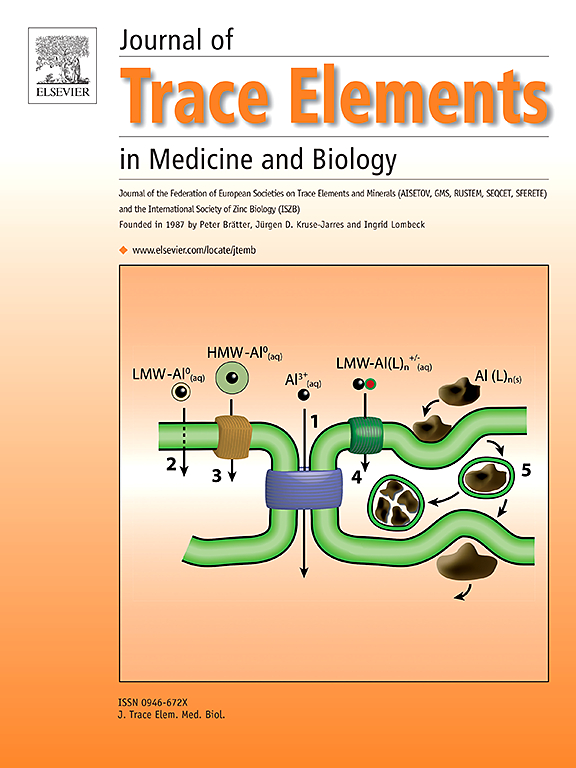肠道微生物群:镉中毒的关键参与者——疾病、干预和综合毒物暴露的影响。
IF 3.6
3区 医学
Q2 BIOCHEMISTRY & MOLECULAR BIOLOGY
Journal of Trace Elements in Medicine and Biology
Pub Date : 2024-11-23
DOI:10.1016/j.jtemb.2024.127570
引用次数: 0
摘要
镉(Cd)是一种剧毒重金属污染物,由于人类活动,如采矿和工业排放,在土壤和水中发现。Cd可在体内积累,导致各种健康风险,如器官损伤、骨质疏松症、肾功能障碍、2型糖尿病(T2DM)、生殖疾病、高血压、心血管疾病和癌症。肠道对Cd毒性特别敏感,因为它是防止口服Cd的主要屏障。即使在低浓度下,Cd也会引起氧化应激、炎症和肠道出血。Cd还会破坏肠道菌群,影响其结构、分类组成和代谢功能。Cd暴露改变了肠道微生物群落的结构,减少了多样性并上调了某些门和属。这种干扰可导致生理和代谢失衡,包括能量稳态、氨基酸、脂质、核苷酸和短链脂肪酸(SCFAs)代谢的破坏。Cd对肠道微生物群的影响取决于接触Cd的持续时间和剂量,并可能因性别和年龄而异。cd诱导的肠道失调与多种疾病有关,包括糖尿病、肥胖、动脉粥样硬化、肝损伤、感染、癌症和神经退行性疾病。针对肠道微生物群的干预措施,如益生菌、特定饮食、褪黑素、硒、维生素D3和某些化合物,已显示出降低与Cd暴露相关的健康风险的潜力。然而,同时暴露于镉和其他有毒物质,如微塑料(MPs)、重金属和抗生素,会加剧肠道微生物群的毒性和生态失调。本文章由计算机程序翻译,如有差异,请以英文原文为准。
The gut microbiota: A key player in cadmium toxicity - implications for disease, interventions, and combined toxicant exposures
Cadmium (Cd) is a highly toxic heavy metal contaminant found in soil and water due to human activities such as mining and industrial discharge. Cd can accumulate in the body, leading to various health risks such as organ injuries, osteoporosis, renal dysfunction, Type 2 diabetes (T2DM), reproductive diseases, hypertension, cardiovascular diseases, and cancers. The gut is particularly sensitive to Cd toxicity as it acts as the primary barrier against orally ingested Cd. Even at low concentrations, Cd can cause oxidative stress, inflammation, and intestinal bleeding. Cd also disrupts the gut microbiota, affecting its structure, taxonomic composition, and metabolic functions. Cd exposure alters the structure of the gut microbial community, reducing diversity and upregulating certain phyla and genera. This disturbance can lead to physiological and metabolic imbalances, including disruptions in energy homeostasis, amino acid, lipid, nucleotide, and short-chain fatty acid (SCFAs) metabolism. The effects of Cd on the gut microbiota depend on the duration of exposure, the dose of Cd, and can vary based on sex and age. Cd-induced gut dysbiosis has been linked to various diseases, including diabetes, adiposity, atherosclerosis, liver damage, infections, cancer, and neurodegenerative diseases. Interventions targeting the gut microbiota, such as probiotics, specific diets, melatonin, selenium, vitamin D3, and certain compounds, have shown potential in reducing the health risks associated with Cd exposure. However, combined exposure to Cd and other toxicants, such as microplastics (MPs), heavy metals, and antibiotics, can amplify the toxicity and dysbiosis in the gut microbiota.
求助全文
通过发布文献求助,成功后即可免费获取论文全文。
去求助
来源期刊
CiteScore
6.60
自引率
2.90%
发文量
202
审稿时长
85 days
期刊介绍:
The journal provides the reader with a thorough description of theoretical and applied aspects of trace elements in medicine and biology and is devoted to the advancement of scientific knowledge about trace elements and trace element species. Trace elements play essential roles in the maintenance of physiological processes. During the last decades there has been a great deal of scientific investigation about the function and binding of trace elements. The Journal of Trace Elements in Medicine and Biology focuses on the description and dissemination of scientific results concerning the role of trace elements with respect to their mode of action in health and disease and nutritional importance. Progress in the knowledge of the biological role of trace elements depends, however, on advances in trace elements chemistry. Thus the Journal of Trace Elements in Medicine and Biology will include only those papers that base their results on proven analytical methods.
Also, we only publish those articles in which the quality assurance regarding the execution of experiments and achievement of results is guaranteed.

 求助内容:
求助内容: 应助结果提醒方式:
应助结果提醒方式:


